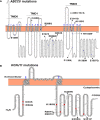Molecular Genetics, Clinical Characteristics, and Treatment Outcomes of KATP-Channel Neonatal Diabetes Mellitus in Vietnam National Children's Hospital
- PMID: 34566892
- PMCID: PMC8458931
- DOI: 10.3389/fendo.2021.727083
Molecular Genetics, Clinical Characteristics, and Treatment Outcomes of KATP-Channel Neonatal Diabetes Mellitus in Vietnam National Children's Hospital
Abstract
Background: Neonatal diabetes mellitus (NDM) is defined as insulin-requiring persistent hyperglycemia occurring within the first 6 months of life, which can result from mutations in at least 25 different genes. Activating heterozygous mutations in genes encoding either of the subunits of the ATP-sensitive K+ channel (KATP channel; KCNJ11 or ABCC8) of the pancreatic beta cell are the most common cause of permanent NDM and the second most common cause of transient NDM. Patients with NDM caused by KATP channel mutations are sensitive to sulfonylurea (SU) treatment; therefore, their clinical management can be improved by replacing insulin with oral agents.
Patients and methods: Seventy patients were diagnosed with NDM between May 2008 and May 2021 at Vietnam National Children's Hospital, and molecular genetic testing for all genes known to cause NDM was performed at the Exeter Genomic Laboratory, UK. Patients with ABCC8 or KCNJ11 mutations were transferred from insulin to oral SU. Clinical characteristics, molecular genetics, and annual data relating to glycemic control, SU dose, severe hypoglycemia, and side effects were collected. The main outcomes of interest were SU dose, SU failure (defined as permanent reintroduction of daily insulin), and glycemic control (HbA1c).
Results: Fifty-four of 70 patients (77%) with NDM harbored a genetic mutation and of these; 27 (50%) had activating heterozygous mutations in ABCC8 or KCNJ11. A total of 21 pathogenic mutations were identified in the 27 patients, including 13 mutations in ABCC8 and 8 mutations in KCNJ11. Overall, 51% had low birth weight (below 3rd percentile), 23 (85%) were diagnosed before 3 months of age, and 23 (85%) presented with diabetic ketoacidosis. At diagnosis, clinical and biochemical findings (mean ± SD) were pH 7.16 ± 0.16; , 7.9 ± 7.4 mmol/L; BE, -17.9 ± 9.1 mmol/L; HbA1C, 7.98% ± 2.93%; blood glucose, 36.2 ± 12.3 mmol/L; and C-peptide median, 0.09 (range, 0-1.61 nmol/l). Twenty-six patients were successfully transferred from insulin to SU therapy. In the remaining case, remission of diabetes occurred prior to transfer. Glycemic control on SU treatment was better than on insulin treatment: HbA1c and blood glucose level decreased from 7.58% ± 4.63% and 19.04 ± 14.09 mmol/L when treated with insulin to 5.8 ± 0.94% and 6.87 ± 3.46 mmol/L when treated with SU, respectively.
Conclusions: This is the first case series of NDM patients with ABCC8/KCNJ11 mutations reported in Vietnam. SU is safe in the short term for these patients and more effective than insulin therapy, consistent with all studies to date. This is relevant for populations where access to and cost of insulin are problematic, reinforcing the importance of genetic testing for NDM.
Keywords: ABCC8 mutations; KCNJ11 mutations; diabetes mellitus in infants; neonatal diabetes mellitus; sulfonylureas treatment in neonatal diabetes mellitus.
Copyright © 2021 Ngoc, Dien, De Franco, Ellard, Houghton, Lan, Thao, Khanh, Flanagan, Craig and Dung.
Conflict of interest statement
The authors declare that the research was conducted in the absence of any commercial or financial relationships that could be construed as a potential conflict of interest.
Figures


References
Publication types
MeSH terms
Substances
Supplementary concepts
Grants and funding
LinkOut - more resources
Full Text Sources
Medical

